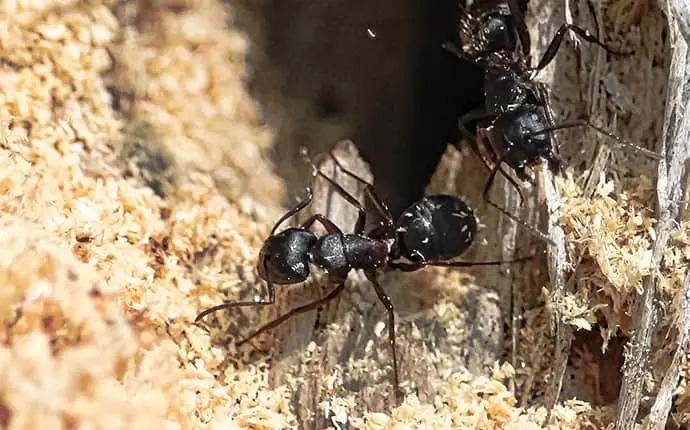The US is home to more than 792 ant species of the approximately 13,200 species identified globally. Carpenter ants remain by far the most destructive ant type in North America. The tiny, black insects curve tunnels in structural wood to create nesting and brooding spots. Carpenter ants usually choose lumber moistened by water leaks or condensation, making it easier to gnaw at. The bugs can cause immeasurable damage to wooden sections in your home, including foundations, basements, eaves, and walls. Proactive pest control in North Carolina is critical to eliminating this destructive pest from your home.
Where Are Typical Carpenter Ant Nesting Sites?
Carpenter ants don’t eat the wood they nest in. They scratch and carve out spaces in the wood to create tunnels and chambers within it. Their preference for damp woods means the nesting sites are found in wood or trees near a water source. Common places you can find a carpenter ant colony in your home include:
- Under sinks
- Chimneys
- Door frames
- Roof eaves
- Wall voids
- Bathrooms
You may also find colonies in decaying trees, stumps, logs, woodpiles, patio boards, and fences in your exteriors. Black carpenter ants in your home can remain hidden for long periods, with the damage increasing as they set up satellite colonies. Call professional pest exterminators immediately if you suspect an ant infestation on your property. We can help you rid your Raleigh home of Carpenter ants and the risks they bring.
Is It Possible To Hear Carpenter Ants Chewing A Wall?
Carpenter ants are usually larger than other ants you might find in your home. While they can reach a length of three-quarters of an inch, most other house-invading ants only get half that size. Their large size and ferocious tunneling habits mean you can hear them chewing through your walls.
You may need a mechanical or electrical stethoscope to pinpoint the exact location of the colony behind your wall voids. Most people associate the sound with crinkling cellophane. The rustling sounds become louder at night as the ants are nocturnal. Burrowing noises are one of the common signs of carpenter ants in your house.
What Not To Do About Carpenter Ant Damage
Hearing thousands of tiny jaws gnawing away on your window frame can be unsettling. You may rush carpenter ant treatment that backfires, worsening the infestation. Here are common errors to avoid as you get rid of carpenter ants in your home:
1. Misidentifying The Ant Infestation
Most homeowners will often confuse a carpenter ant infestation with termite damage. The hollowed wood with galleries running into the heart of the wood can lead to misidentification. Treating the wrong pest can lead to wasted resources and worsen the infestation.
2. Ignoring Signs of Carpenter Ants Within The Home
Carpenter ants are black, approximately half an inch long. Failing to notice the signs of the ant’s damage can lead to you learning of the infestation when it’s too late. Common indicators of carpenter ants in your house include:
- Black, larger ants spotted crawling out of crevices or wood surfaces
- Carpenter ant frass in your home
- Rustling sounds in your walls
If unsure of the ant infestation, call a pest control expert for accurate identification.
3. Over-Reliance On DIY Ant Control Hacks
Most homeowners will try to use ineffective natural bug repellants such as cinnamon or boric acid to eliminate the ants. Sadly, the wrong application of the carpenter ant spray means the colony survives. The only way to guarantee the ants won’t return to your property is to use a professional exterminator.
Carpenter Ant Extermination Done Right
Professional ant control specialists are your best bet at correctly identifying the carpenter ants and eliminating them for good. Innovative Pest Solutions has formally-trained and experienced exterminators who can conduct a thorough inspection to identify the different nests within your home.
Our experts can then recommend carpenter ant spray and advanced bait systems to eradicate the infestation. Call us today to discuss your pest problem and explore ways we can solve them for you.






